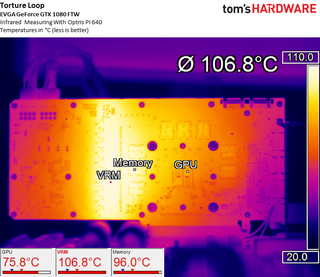EVGA Addresses GeForce GTX 1080 FTW PWM Temperature Problems (Update 2: All BIOS Updates Available)
Update, 11/14/16, 8am PT: It looks like EVGA has finished pushing out BIOS updates for all affected cards. There are 19 primary BIOS updates and six secondary BIOS updates. The list of affected graphics cards is towards the bottom of this page, and you can head here to download the BIOS for yours.
Update, 11/3/16, 12pm PT: EVGA is beginning to push out BIOS updates for its affected cards. At publication time, there are five available:
EVGA GeForce GTX 1080 SC ACX 3.0EVGA GeForce GTX 1080 FTW ACX 3.0EVGA GeForce GTX 1070 SC ACX 3.0 Black EditionEVGA GeForce GTX 1070 SC ACX 3.0EVGA GeForce GTX 1070 FTW ACX 3.0
Original article:

EVGA announced plans to address temperature problems with its GeForce GTX 1080/1070 FTW graphics that use its ACX 3.0 cooling solution. According to reports, including from Tom's Hardware Germany (an English translation is forthcoming), the issues emerged under the Furmark stress utility and are said to affect the thermal temperature of the PWM and memory in "extreme circumstances."
The company said on that it ran similar tests when it designed the products, then retested them after reviews discovered the issue, and found both times that the "temperature of PWM and memory is within the spec tolerance" and "is working as originally designed with no issues." Still, the company said it "understands that lower temperatures are preferred by reviewers and customers," which is why it's taking these steps to fix the issue.
EVGA said that it plans to release a VBIOS update in the next few days to adjust the fan-speed curve and "ensure sufficient cooling of all components across all operating temperatures." People uncomfortable with installing the VBIOS update themselves can request a warranty cross-shipment to receive a replacement with the update pre-installed; any EVGA graphics cards shipped after November 1, 2016 will also come with the update already installed.
Stay on the Cutting Edge
Join the experts who read Tom's Hardware for the inside track on enthusiast PC tech news — and have for over 25 years. We'll send breaking news and in-depth reviews of CPUs, GPUs, AI, maker hardware and more straight to your inbox.
Here's the full list of cards supported by this update:
| GTX 1080 | GTX 1070 | GTX 1060 6G | GTX 1060 3G |
|---|---|---|---|
| 08G-P4-6181 | 08G-P4-5171 | 06G-P4-6262 | 03G-P4-6365 |
| 08G-P4-6183 | 08G-P4-5173 | 06G-P4-6366 | 03G-P4-6367 |
| 08G-P4-6284 | 08G-P4-6171 | 06G-P4-6265 | Row 2 - Cell 3 |
| 08G-P4-6286 | 08G-P4-6173 | 06G-P4-6264 | Row 3 - Cell 3 |
| 08G-P4-6384 | 08G-P4-6274 | 06G-P4-6267 | Row 4 - Cell 3 |
| 08G-P4-6386 | 08G-P4-6276 | 06G-P4-6368 | Row 5 - Cell 3 |
EVGA said that customers affected by these temperature problems can also request a free thermal pad kit. The company said this update isn't required, and that running at the higher temperatures won't damage its cards, but people who want a little more peace of mind can employ it. Requests for the free kit became available on October 24, 2016--EVGA has not said when it expects to start shipping the thermal pads to consumers.
The temperature issues are said to only affect cards using the ACX 3.0 cooling solution; the Founders Edition, Blower type, Hybrid, and Hydro Copper editions of its GPUs are not affected. EVGA has not said when the VBIOS update will be available, but it should debut sooner rather than later.

Nathaniel Mott is a freelance news and features writer for Tom's Hardware US, covering breaking news, security, and the silliest aspects of the tech industry.
-
oczdude8 Pretty bummed with my 1080ftw. First, it had the black screening during games which was a known issue, and now this. Granted I know its not really an issue, especially since I want to watercool it soon, but it leaves a bad taste in your mouth after spending $1k. Combined with pretty loud coil whine, I wouldn't really recommend it to anyone.Reply
Its too bad because it performs so good and EVGA customer support has been pretty good so far though.... -
ssdpro Odd title for this piece, considering it is just about every EVGA 1080, 1070,and even 1060 product except the FE cards. Full chart here: http://forums.evga.com/download.axd?file=0;2573491&where=&f=Update.jpgReply -
Jeff Fx > found both times that the "temperature of PWM and memory is within the spec tolerance" and "is working as originally designed with no issues."Reply
Maybe they tested it with perfect case-ventilation and a single video card. The real world isn't like that, and a well-designed card would shut down rather than burning up if it gets too hot.
Cranking up the fans might be a really bad substitute for proper heat-sinks and cooling. -
Jeff Fx Reply18814711 said:Pretty bummed with my 1080ftw. First, it had the black screening during games which was a known issue, and now this. Granted I know its not really an issue, especially since I want to watercool it soon, but it leaves a bad taste in your mouth after spending $1k. Combined with pretty loud coil whine, I wouldn't really recommend it to anyone.
Its too bad because it performs so good and EVGA customer support has been pretty good so far though....
My 1080 Strix has now crashed a couple of times when in overclock mode, which is also pretty disappointing. We pay a price in stability when we buy cutting-edge products. I may water-cool as well, but I'm a little shy about that after having a motherboard destroyed when a hose developed a slow leak years ago. -
Jeff Fx Reply18815424 said:That damn thing EXPLODED on me... not even a joke. Never again...!
Isn't that the coolest way for electronics to self-destruct as long as they're not near your body? -
metathias Alot of people gave the FE a hard time when it released first, Saying it was a poor design, But i've always felt just the opposite. The vast majority of 3rd party boards next to the water hybrids are using axial fans for their cooling system. I've learned the hard many times, and in many disparate fields that axial fans are fundamentally prone to breakdown. It has to do with the perpendicular application of forces against the axle and subsequent bearing contact. I know this seems kind of beside the point to subject of the article, But effectively if you cant design a cooling system using reliable fan types, Your probably not a good enough engineer to design the heatsinks, VRMs, And other extraneous hardware either. IE there is a reason for NVIDIAs design decisions, And i guarantee you it goes much deeper than these 3rd parties are willing to let on.Reply -
jdlech EVGA says the higher temperatures won't harm the cards. This is really quite amusing. I've seen pictures with a hole burned right through the card. How is that not harmed?Reply
I have a sneaking suspicion that the fan speed adjustment might not be enough in many situations. You may have to dial back the cards - which defeats the purpose of paying all those big bucks. Wouldn't want to be in EVGAs shoes the next 12 months or so. -
LoreeSelmer My experience with thermal solutions has been as an IC developer and user, basically using theta_JC and theta_CA (thermal resistance from IC junction-to-case and cooling solution case-to-ambient) and worst case power dissipation to determine what kind of maximum ambient temperature can be tolerated to hold junction temperature below a maximum specified level.Reply
That said, I am new to overclocking and related cooling solutions. I understand the square law relationship for power dissipation wrt. clock frequency and wrt. supply voltage. As I contemplate a new build and look at various cooling solutions, I can't help but notice there is nothing defining thermal resistance in the cooler specs. I understand it typically depends on PWM-controlled fan speed, but it seems that a graph could be provided defining thermal resistance from IC case to enclosure ambient wrt. fan speed from 0 to 100% PWM.
Without a thermal resistance number there is some guesswork, Kentucky windage, whatever you want to call it, in your choice of cooling solution. Even if you know your maximum room and enclosure internal temperatures, without the thermal resistance of the cooling solution you can't analytically predict what the IC temperature will be in a prolonged high power state.
I'm guessing that experienced builders and overclockers rely on their feel for acceptable room temperature and case air flow, and for the performance of known cooling solutions. Less experienced folks have a trial and error process on their hands, which as noted above can get pretty exciting if it gets away from you!
Is that pretty much how this exercise goes, or is there a first-order engineering solution that, for a given cooler and specs from manufacturer X, allows you to ballpark a maximum IC temperature from enclosure air temperature? -
bit_user First, I want to say I'm disheartened to learn of these problems. I love my GTX 980 Ti FTW, and was contemplating getting a GTX 1070 FTW for a second computer. I hope EVGA improves their VRM cooling in ACX 4.0.Reply
Well, people look at testbench measurements of different heatsinks w/ various CPUs (like what you'll find in the reviews section of this site). Most of the better measurements will indicate temperatures relative to ambient. Some will post absolute temps and state ambient. I've almost never seen anyone try to control for humidity.18816286 said:I'm guessing that experienced builders and overclockers rely on their feel for acceptable room temperature and case air flow, and for the performance of known cooling solutions. Less experienced folks have a trial and error process on their hands, which as noted above can get pretty exciting if it gets away from you!
Is that pretty much how this exercise goes, or is there a first-order engineering solution that, for a given cooler and specs from manufacturer X, allows you to ballpark a maximum IC temperature from enclosure air temperature?
So, you can either use that experimental data to guide your selection, or you can read reviews on amazon/newegg and read people's experiences in forums on this site & others. Either way, it's more an exercise of replicating what someone else has claimed to work. That, or just trying something that seems adequate and being willing to upgrade if it's not.
It really comes down to your goals. A small overclock is easily achievable on a big air cooler. For larger overclocks, you're looking at water cooling, delid, lapping, and even mounting it directly atop the die.
Good luck. You'll find much better info in here: http://www.tomshardware.com/forum/forum-29.html
Most Popular






